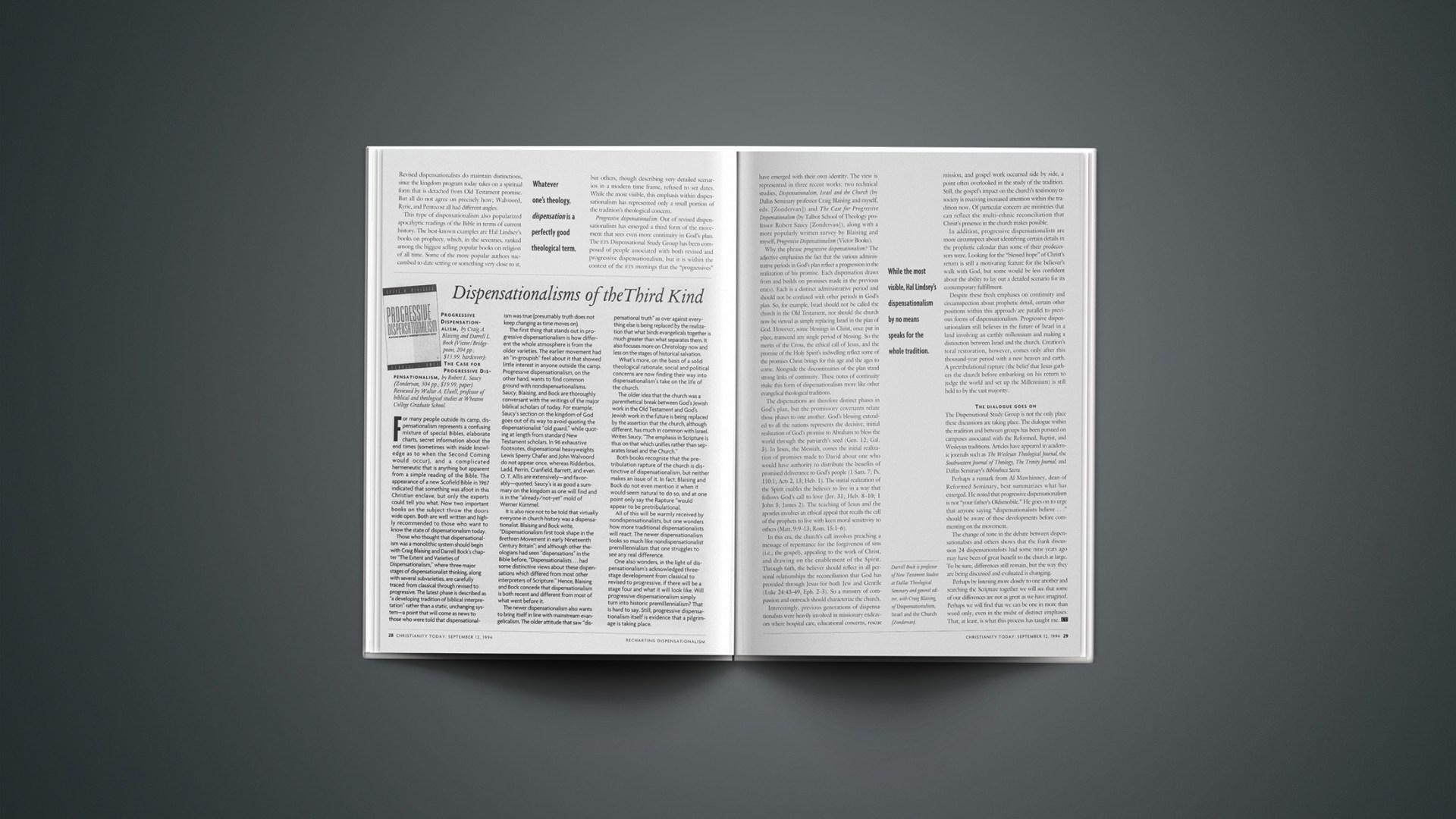“Progressive Dispensationalism,” by Craig A. Blaising and Darrel L. Bock (Victor/Bridgepoint, 204 pp.; $15.99, hardcover); “The Case For Progressive Dispensationalism,” by Robert L. Saucy (Zondervan, 304 pp.; $19.99, paper). Reviewed by Walter A. Elwell, professor of biblical and theological studies at Wheaton College Graduate School.
For many people outside its camp, dispensationalism represents a confusing mixture of special Bibles, elaborate charts, secret information about the end times (sometimes with inside knowledge as to when the Second Coming would occur), and a complicated hermeneutic that is anything but apparent from a simple reading of the Bible. The appearance of a new Scofield Bible in 1967 indicated that something was afoot in this Christian enclave, but only the experts could tell you what. Now two important books on the subject throw the doors wide open. Both are well written and highly recommended to those who want to know the state of dispensationalism today.
Those who thought that dispensationalism was a monolithic system should begin with Craig Blaising and Darrell Bock’s chapter the “Extent and Varieties of Dispensationalism,” where three major stages of dispensationalist thinking along with several subvarieties, are carefully traced: from classical through revised to progressive. The latest phase is described as “a developing tradition of biblical interpretation” rather than a static, unchanging system—a point that will come as news to those who were told that dispensationalism was true (presumably truth does not keep changing as time moves on).
The first thing that stands out in progressive dispensationalism is how different the whole atmosphere is from the older varieties. The earlier movement had an “in-groupish” feel about it that showed little interest in anyone outside the camp. Progressive dispensationalism, on the other hand, wants to find common ground with nondispensationalisms. Saucy, Blaising, and Bock are thoroughly conversant with the writings of the major biblical scholars of today. For example, Saucy’s section on the kingdom of God goes out of its way to avoid quoting the dispensationalist “old guard,” while quoting at length from standard New Testament scholars. In 96 exhaustive footnotes, dispensational heavyweights Lewis Sperry Chafer and John Walvoord do not appear once, whereas Ridderbos, Ladd, Perrin, Cranfield, Barrett, and even O. T. Allis are extensively—and favorably—quoted. Saucy’s is as good a summary on the kingdom as one will find and is in the “already/not-yet” mold of Werner Kummel.
It is also nice not to be told that virtually everyone in church history was a dispensationalist. Blaising and Bock write, “Dispensationalism first took shape in the Brethren Movement in early Nineteenth Century Britain”; and although other theologians had seen “dispensations” in the Bible before, “Dispensationalists … had some distinctive views about these dispensations which differed from most other interpreters of Scripture.” Hence, Blaising and Bock concede that dispensationalism is both recent and different from most of what went before it.
The newer dispensationalism also wants to bring itself in line with mainstream evangelicalism. The older attitude that saw “dispensational truth” as over against everything else is being replaced by the realization that what binds evangelicals together is much greater than what separates them. It also focuses more on Christology now and less on the stages of historical salvation. What’s more, on the basis of a solid theological rationale, social and political concerns are now finding their way into dispensationalism’s take on the life of the church.
The older idea that the church was a parenthetical break between God’s Jewish work in the Old Testament and God’s Jewish work in the future is being replaced by the assertion that the church, although different, has much in common with Israel. Writes Saucy, “The emphasis in Scripture is thus on that which unifies rather than separates Israel and the Church.”
Both books recognize that the pretribulation rapture of the church is distinctive of dispensationalism, but neither makes an issue of it. In fact, Blaising and Bock do not even mention it when it would seem natural to do so, and at one point only say the Rapture “would appear to be pretribulational.
All of this will be warmly received by nondispensationalists, but one wonders how more traditional dispensationalists will react. The newer dispensationalism looks so much like nondispensationalist premillennialism that one struggles to see any real difference.
One also wonders, in the light of dispensationalism’s acknowledged threestage development from classical to revised to progressive, if there will be a stage four and what it will look like. Will progressive dispensationalism simply turn into historic premillennialism? That is hard to say. Still, progressive dispensationalism itself is evidence that a pilgrimage is taking place.
Copyright © 1994 Christianity Today. Click for reprint information.










